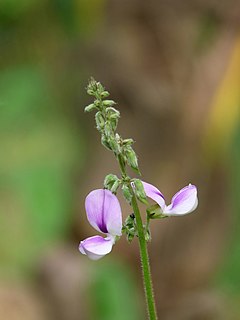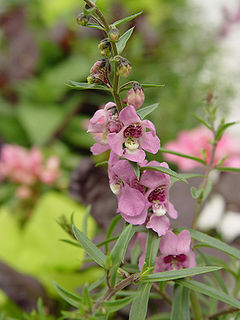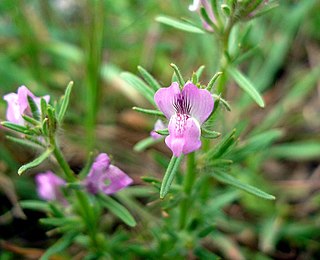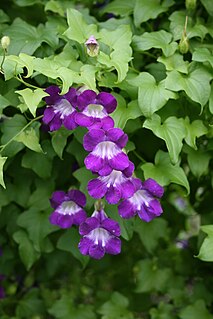
Antirrhinum is a genus of plants commonly known as dragon flowers, snapdragons and dog flower because of the flowers' fancied resemblance to the face of a dragon that opens and closes its mouth when laterally squeezed. They are native to rocky areas of Europe, the United States, Canada, and North Africa. It is widely used as an ornamental plant in borders and as a cut flower.

Pueraria is a genus of 15–20 species of legumes native to Asia. The best known member is kudzu, also called Japanese arrowroot. The genus is named after 19th century Swiss botanist Marc Nicolas Puerari.

Angelonia is a genus of about 30 species which occur from Mexico to Argentina and is classified in the Plantaginaceae. They are herbaceous plants occurring mainly in arid and semi-arid habitats. Most Angelonia species can be found in Northeastern Brazil in the Seasonally Dry Tropical Forest namely Caatinga. The flowers of Angelonia are highly specialized for pollination because they have hairs in the inner corolla, which produces oils collected by oil bee pollinators, especially of the genus Centris.

Galvezia is a genus of perennial plants which are native to western South America and the Galapagos Islands. The genus is currently placed in the family Plantaginaceae, having been formerly classified under Scrophulariaceae. It is named in honour of José de Gálvez, a colonial official in New Spain during the 1700s.

Linderniaceae is a family of flowering plants in the order Lamiales, which consists of about 25 genera and 265 species occurring worldwide. Vandellia micrantha is eaten in Laos, but tastes bitter. Best known are the wishbone flowers Torenia fournieri and Torenia thouarsii, which are used as bedding plants especially in the tropics. Micranthemum is sold as an aquarium plant when it is called 'baby tears'.

Banara is a genus of flowering plants in the family Salicaceae.

Nanorrhinum is a genus of flowering plant in family Plantaginaceae.

Kickxia is a genus of plants in the plantain family (Plantaginaceae). It includes several species known commonly as cancerworts or fluellins. Species are mostly native to Europe, Central Asia, and Africa, with two, K. elatine and K. spuria, well-established as invasive elsewhere.

Misopates is a genus of the family Plantaginaceae, and is one of the groups of plants commonly known as 'snapdragons'. It has eight accepted species:

Wulfenia is a plant genus in the family Plantaginaceae. The genus was named after Franz Xaver von Wulfen (1728–1805), an Austrian botanist, zoologist, mineralogist, alpinist, and Jesuit priest. It was first described in 1781 by Nikolaus Joseph von Jacquin in. It is also in Tribe Veroniceae.

Veronica stricta, synonym Hebe stricta, commonly called koromiko, is a flowering plant in the family Plantaginaceae, which is endemic to New Zealand.

Acmispon is a genus of flowering plant in the family Fabaceae (legumes), native to North America and the west coast of Chile in South America. It includes several species of American bird's-foot trefoils and deervetches formerly contained in the globally distributed genus Lotus. The former genus Syrmatium is included in Acmispon. The Jepson eFlora accepts only Acmispon.

Maurandya is a genus of flowering plants in the family Plantaginaceae, native to Mexico and the south west United States. They sprawl or climb by means of twining leaf stalks. One of the four species, Maurandya barclayana, is widely cultivated as an ornamental plant.

The Antirrhineae are one of the 12 tribes of the family Plantaginaceae. It contains the toadflax relatives, such as snapdragons.

Syrmatium was a formerly accepted genus of flowering plants in the family Fabaceae (legumes), native to the southwestern United States. As of February 2021, it was considered a synonym of Acmispon by Plants of the World Online, and only Acmispon was recognized by the Jepson eFlora.

Tetranema is a genus of flowering plants in the family Plantaginaceae, native to Mexico and Central America. There has been some taxonomic debate over its family placement, with Gesneriaceae and Scrophulariaceae having been proposed.

Tonella is a genus of flowering plants belonging to the family Plantaginaceae.
Schistophragma is a genus of flowering plants belonging to the family Plantaginaceae.

Gambelia is a genus of flowering plants in the Antirrhineae tribe of the plantain family commonly known as bush snapdragons. This genus is native to northwestern Mexico, particularly the Baja California Peninsula, but species are also found on the coast of Sonora, Guadalupe Island, and the Channel Islands of California. The genus is named in honor of William Gambel (1823–1849), an American naturalist, ornithologist, and botanist.
Benjaminia is a monotypic genus of flowering plants belonging to the family Plantaginaceae. It only contains one known species, Benjaminia reflexa(Benth.) D'Arcy.


















